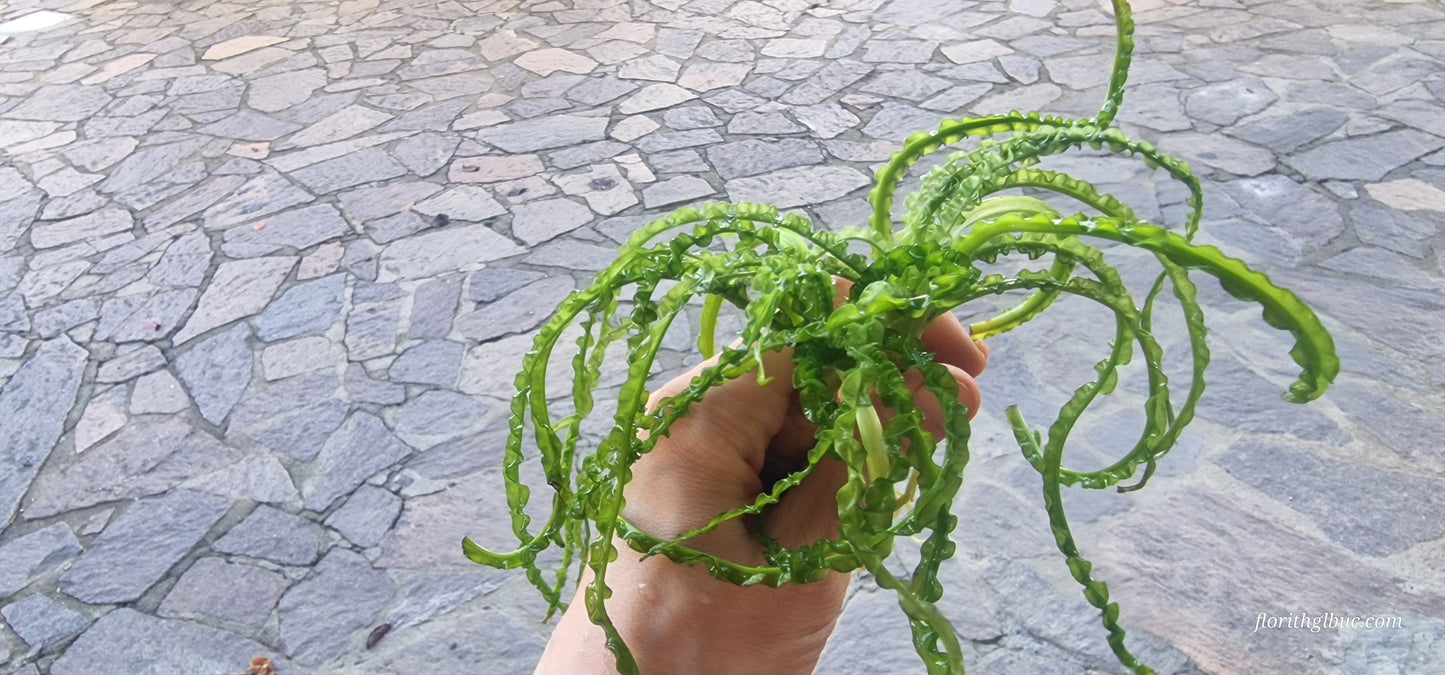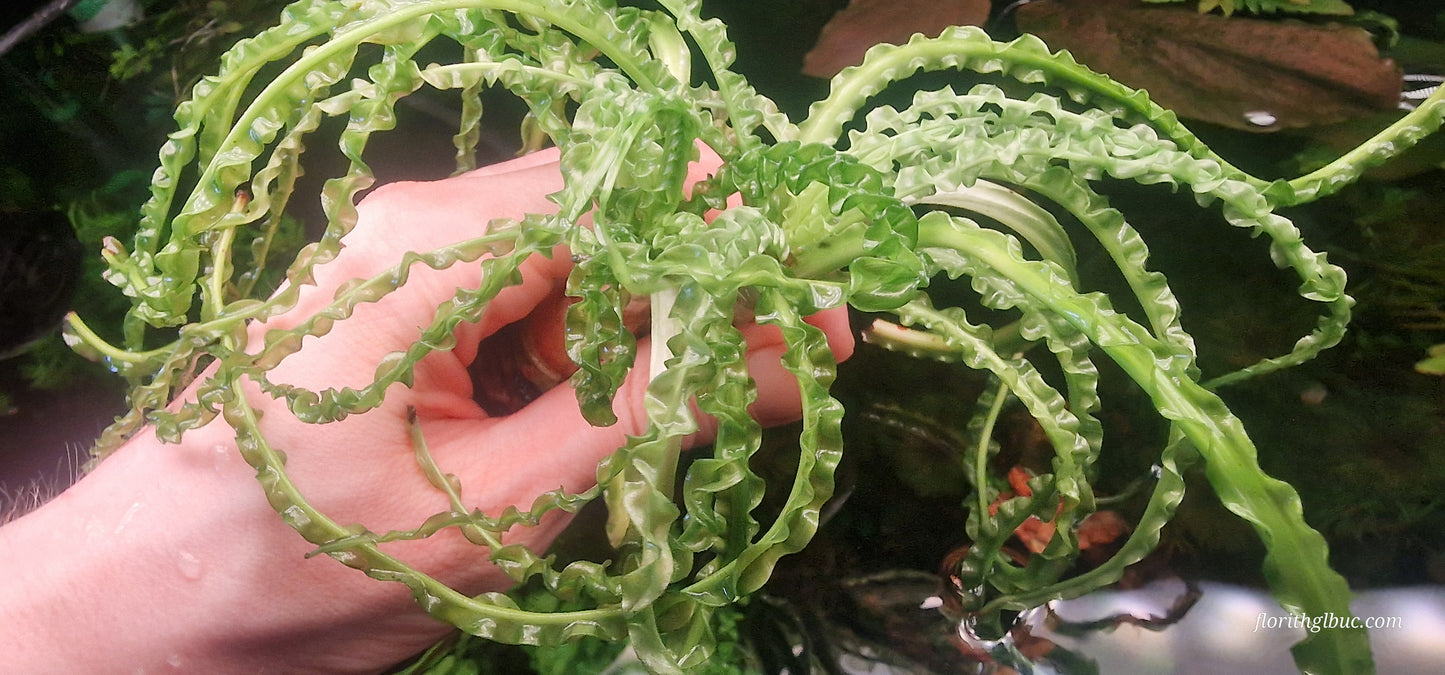Crinum calamistratum 1 plants mother
Crinum calamistratum 1 plants mother
Couldn't load pickup availability
English
Crinum calamistratum is one of the most iconic aquatic plants, native to West Africa, admired for its long, narrow, curly leaves that create an elegant, flowing effect in the aquarium. Its ribbon-like foliage can reach impressive lengths, swaying gently with the current and giving a natural, dynamic look to the layout. Growth is slow compared to stem plants, but once established it becomes a true centerpiece, ideal for large aquariums or as a solitary focal point.
Cultivation requires stable conditions: medium to strong lighting (25–40 PAR, 1500–2500 lumens depending on tank size), CO₂ injection (20–30 ppm) and a complete fertilization program with particular attention to potassium and micronutrients to support healthy leaf development. Recommended water parameters: pH 5.5–6, GH 6–7, KH 2, conductivity 150–200 µS.
Adaptation: the plants are already grown submerged, adult, and acclimatized. They will not melt after planting and, once rooted firmly, they produce new leaves consistently and can live for many years.
Reproduction occurs mainly through the formation of small side bulbs (offsets) growing from the main bulb. Once they reach 3–5 cm in size with roots of their own, they can be carefully detached and replanted as new plants. In rare cases, mature specimens may also produce a flower stalk with large white blossoms; if pollinated, the plant can form seeds, but this is very uncommon under aquarium conditions.
Collectors and aquascapers value Crinum calamistratum for its longevity, resilience, and dramatic appearance. Few plants can provide such movement and elegance—this species is a living sculpture in your aquarium.
---
Italiano
Crinum calamistratum è una delle piante acquatiche più iconiche, originaria dell’Africa occidentale, apprezzata per le sue lunghe foglie sottili e arricciate che creano un effetto elegante e dinamico in acquario. Il fogliame nastriforme può raggiungere dimensioni notevoli, muovendosi con grazia nella corrente e donando un aspetto naturale e scenografico alla vasca. La crescita è lenta rispetto alle piante a stelo, ma una volta stabilita diventa una vera protagonista, ideale per acquari grandi o come esemplare singolo di richiamo visivo.
Per una coltivazione ottimale richiede condizioni stabili: illuminazione media-intensa (25–40 PAR, 1500–2500 lumen a seconda della vasca), apporto di CO₂ (20–30 ppm) e fertilizzazione completa con attenzione particolare al potassio e ai microelementi per favorire lo sviluppo fogliare. Valori consigliati: pH 5.5–6, GH 6–7, KH 2, conducibilità 150–200 µS.
Adattamento: le piante sono già adulte, cresciute in forma sommersa e acclimatate. Non si sciolgono una volta piantumate e, dopo aver attecchito saldamente, producono nuove foglie con regolarità, vivendo per molti anni.
La riproduzione avviene principalmente attraverso la formazione di bulbilli laterali che crescono dal bulbo principale. Una volta raggiunti i 3–5 cm e sviluppate radici proprie, possono essere separati con delicatezza e ripiantati come nuove piante. In rari casi, esemplari maturi possono anche emettere un fusto floreale con grandi fiori bianchi; se impollinati, producono semi, ma questo fenomeno è molto raro in acquario.
Collezionisti e aquascaper apprezzano Crinum calamistratum per la sua longevità, resistenza e aspetto scenografico. Poche piante sanno donare così tanto movimento ed eleganza: è una vera scultura vivente dentro l’acquario.
---
Français
Crinum calamistratum est l’une des plantes aquatiques les plus emblématiques, originaire d’Afrique de l’Ouest. Elle se distingue par ses longues feuilles étroites et ondulées, qui créent un effet fluide et élégant dans l’aquarium. Son feuillage en ruban peut atteindre de grandes dimensions, se balançant doucement dans le courant et apportant une touche naturelle et artistique au décor. Sa croissance est lente par rapport aux plantes à tige, mais une fois bien installée, elle devient une véritable plante maîtresse, idéale pour les grands aquariums ou comme pièce unique.
Pour sa culture, il est nécessaire de maintenir des conditions stables : éclairage moyen à fort (25–40 PAR, 1500–2500 lumens selon la taille du bac), apport de CO₂ (20–30 ppm) et fertilisation complète, avec une attention particulière au potassium et aux oligo-éléments. Paramètres conseillés : pH 5.5–6, GH 6–7, KH 2, conductivité 150–200 µS.
Adaptation : les plantes sont déjà adultes, cultivées en immersion et bien acclimatées. Elles ne fondent pas après la plantation et, une fois bien enracinées, produisent régulièrement de nouvelles feuilles et peuvent vivre de nombreuses années.
La reproduction se fait principalement par bulbilles latéraux produits par le bulbe principal. Lorsqu’ils atteignent 3–5 cm et possèdent leurs propres racines, ils peuvent être séparés avec précaution et replantés comme de nouvelles plantes. Dans de rares cas, un spécimen mature peut aussi produire une hampe florale avec de grandes fleurs blanches ; si la pollinisation a lieu, des graines peuvent apparaître, mais cela reste exceptionnel en aquarium.
Très prisé des aquascapers et collectionneurs, Crinum calamistratum séduit par sa longévité, sa robustesse et son élégance spectaculaire. Peu de plantes offrent autant de mouvement et de grâce : une véritable sculpture vivante.
---
Deutsch
Crinum calamistratum gehört zu den bekanntesten Aquarienpflanzen Westafrikas. Sie zeichnet sich durch ihre langen, schmalen und gewellten Blätter aus, die im Aquarium einen eleganten, fließenden Effekt erzeugen. Das bandförmige Laub kann beachtliche Längen erreichen und bewegt sich sanft in der Strömung – ein natürlicher und zugleich dekorativer Blickfang. Das Wachstum ist langsam im Vergleich zu Stängelpflanzen, doch sobald sie etabliert ist, entwickelt sie sich zu einem echten Mittelpunkt, besonders in größeren Aquarien.
Für die Kultur sind stabile Bedingungen erforderlich: mittlere bis starke Beleuchtung (25–40 PAR, 1500–2500 Lumen je nach Beckengröße), CO₂-Zugabe (20–30 ppm) und eine vollständige Düngung mit besonderem Augenmerk auf Kalium und Spurenelemente. Empfohlene Wasserwerte: pH 5.5–6, GH 6–7, KH 2, Leitfähigkeit 150–200 µS.
Anpassung: Die Pflanzen sind bereits submers kultiviert, ausgewachsen und akklimatisiert. Sie lösen sich nach dem Einsetzen nicht auf, sondern wachsen nach einer kurzen Eingewöhnung stetig weiter und können viele Jahre alt werden.
Die Vermehrung erfolgt hauptsächlich durch kleine Seitenzwiebeln (Bulbillen), die aus der Hauptzwiebel hervorgehen. Sobald sie 3–5 cm groß sind und eigene Wurzeln besitzen, können sie vorsichtig abgetrennt und separat eingepflanzt werden. In seltenen Fällen bildet eine ausgewachsene Pflanze auch einen Blütenstiel mit großen weißen Blüten; bei erfolgreicher Bestäubung können Samen entstehen, was im Aquarium jedoch äußerst selten vorkommt.
Aquascaper und Sammler schätzen Crinum calamistratum wegen seiner Langlebigkeit, Robustheit und seiner eindrucksvollen Erscheinung. Kaum eine andere Pflanze bringt so viel Bewegung und Eleganz ins Aquarium – eine wahre lebendige Skulptur.




